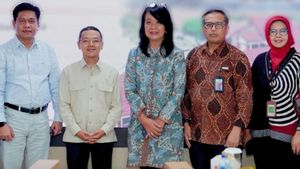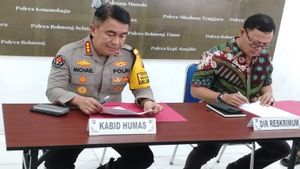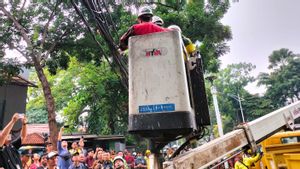JAKARTA - Through the Environmental Social Responsibility Program, PT Pertamina Geothermal Energi Lahendong Area built a black monkey conservation site that only exists in North Sulawesi, Macaca Nigra.
After traveling for about 2.5 hours, the 11 Yaki monkeys (Macaca Nigra) have been occupying the newly built temporary house at the Yaki Monkey Rehabilitation Center on Mount Masarang, Rurukan Village, Tomohon, since early December 2021. Previously, North Sulawesi endemic animals that have been This rare category was rehabilitated at the Tasikoki Wildlife Rescue Center, Bitung. In Tomohon, they undergo a process of habituation to be ready to return to the forest.
This endangered animal rescue project is a collaboration between PT Pertamina Geothermal Energi (PGE) Lahendong Area, North Sulawesi with the Masarang Foundation, a foundation engaged in the conservation of endangered animals, and the North Sulawesi Natural Resources Conservation Center (BKSDA).
"This project is part of PGE's Environmental Social Responsibility Program (TJSL). Here we chose Yaki, which is only available in North Sulawesi," said Dimas Wibisoni, Senior Officer of Government & Public Relations of PT PGE Aea Lahendong, quoted from a written statement received , Monday April 4th.
Thanks to its work in the conservation of Macaca Nigra, PT PGE in the Lahendong area managed to get an award from the Indonesia Green Awards (IGA) 2022. The award was handed over on 21 March. PT PGE Lahendong Area which operates in North Sulawesi received an award in the category of Developing Biodiversity through the program "Conservation of Yaki Fauna - Rehabilitation of Macaca Nigra Species".
PT PGE built a 100 square meter cage in the Masarang forest on land belonging to the Masarang Foundation and financed maintenance operations, including food, vitamins, and medical check-ups. Masarang Foundation provides land, veterinarians, and keepers. The cage is eight meters high, and enough for 11 Yaki monkeys to undergo the habituation process.
"There the Yaki monkeys are monitored for their health and behavior. When they are declared ready, they will be released into the forest," said Dimas.
The plan, this habituation process lasts about 3 years. If all goes well, said Dimas, the 11 Yaki monkeys will be released into the conservation area of the Gunung Ambang natural tourism park (TWA), Modayag, East Bolaang Mongondow, in 2023. This habituation process takes a long time.
"These Yaki characters live in groups. Animal rescuers believe they can survive in the middle of the forest if they have formed a solid group," said Dimas.
Currently, they are still in the process of forming groups because they come from various locations, differ in age, and gender.
"A solid group can be identified if there is already a dominant male monkey (alpha male) who will be the leader of the group," he added.
Seven species of YakiProfessor of the Faculty of Agriculture, Sam Ratulangi University, John Tasirin explained, there are seven species of Yaki in Sulawesi, but only Macaca Nigra that lives in the forests of North Sulawesi. They migrated from Kalimantan to Sulawesi, and ended up in North Sulawesi.
"Historically, the oldest primate in Sulawesi is Tarsier, and Macaca Nigra is the most modern and highly intellectual generation," he said.
The characteristics of Macaca Nigra are thick black hair, there is a crest on the head, and the bottom is pink. Another characteristic is the short tail.
"In general, long-tailed monkeys," he said.
According to Tasirin, there was an evolution of behavioral changes that resulted in the Macaca Nigra's tail shortening.
"He no longer lives in trees, but more on the ground. A long tail to maintain balance when they move from tree to tree," said Tasirin, who holds a doctorate at the University of Tasmania, Australia.
According to this native wildlife conservation expert, Macaca Nigra is getting rarer because its habitat is getting narrower.
"Economic development, population growth, and industrialization have made them not have a comfortable place to live and are able to provide sufficient food. As a result, they go to settlements to get food," said Tasirin.
Their diet includes forest noni, rao fruit, white banyan, mango, and pakoba tamarind. In addition, Macaca Nigra is also hunted for food.
However, said Tasirin, after a lot of socialization, some members of the community have stopped the habit. According to him, socialization must continue, especially among young people, from elementary to high school, so that Macaca Nigra does not continue to decrease.
"The conservation of Macaca Nigra must be carried out because its habitat is a natural laboratory that is second to none in the world," he said.
Macaca Nigra is a protected wildlife in Indonesia. It is regulated in Law no. 5 of 1990 concerning Conservation of Biological Natural Resources and Their Ecosystems, as well as Regulation of the Minister of Environment and Forestry No. 20 of 2018 concerning the Determination of Protected Plants and Animals. Based on these two rules, the hunt for Macaca Nigra must be stopped.
The Lahendong geothermal working area has six power plants with a capacity of 20 MW each. For PLTP Lahendong 1-4 which is located in Lahendong, PT PGE supplies hot steam in the Steam Sale and Purchase Agreement (PJBU) with PT PLN. The last two power plants built, namely PLTP 5 & 6 in Tompaso, are fully managed by PT PGE based on the Power Purchase Agreement (PJBL) with PT PLN.
Dimas said that the first drilling in the Lahendong Working Area was carried out in 1982, but commercial production began in 2001. PT PGE has a concession in Lahendong covering an area of 106,800 hectares. Every day, six power plants in Lahendong operate up to a capacity of 110-118 MW.
"The Lahendong PLTP has become the backbone and serves as a baseload for the North Sulawesi-Gorontalo Electricity System," said Dimas.
Currently, the North Sulawesi-Go Electricity System has five types of power plants, namely PLTU, PLTG, PLTA, PLTP, and PLTS. The total installed capacity reaches 550.78 MW, while the peak load in March 2022 is 422 MW.
"On average, we supply 21-28 percent of electricity needs in North Sulawesi and Gorontalo," said Dimas.
Together with PLTP Kamojang, PLTP Lahendong has received a certificate of emission reduction of 309,000 tons of CO2 Equivalent. PLN includes these two plants in the greenhouse gas emission reduction program through the Clean Development Mechanism (CDM). This CDM model is one of the carbon trading mechanisms regulated in the Kyoto Protocol Agreement.
The English, Chinese, Japanese, Arabic, and French versions are automatically generated by the AI. So there may still be inaccuracies in translating, please always see Indonesian as our main language. (system supported by DigitalSiber.id)













